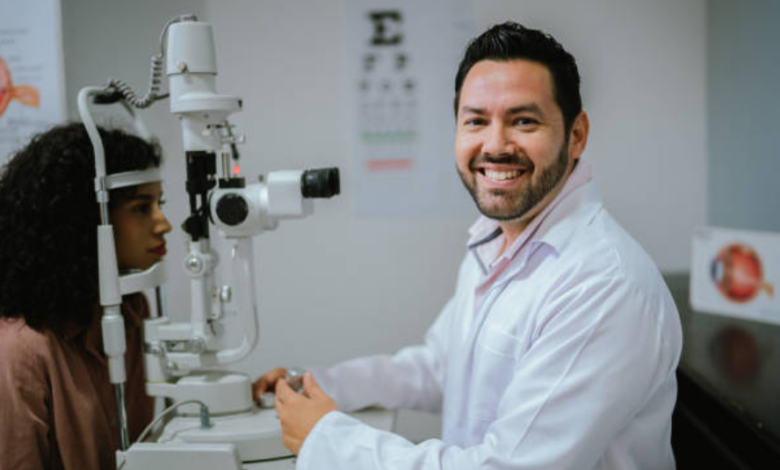How an Optometrist Manages Keratoconus: A Team-Based Path to Clearer Vision

Keratoconus affects thousands of people each year, causing the cornea to thin and bulge into an irregular cone shape. This progressive condition can significantly impact vision quality, making everyday tasks challenging and frustrating. Early detection and proper management are crucial for maintaining clear, comfortable sight throughout your life.
When dealing with keratoconus, finding the right care becomes essential for your long-term vision health. A skilled Mission Hills optometrist plays a central role in managing this complex condition through comprehensive monitoring, specialized lens fitting, and coordinated treatment planning. The team-based approach ensures you receive the most appropriate interventions at each stage of the disease progression.
Understanding the Optometrist’s Role in Keratoconus Management
Primary Monitoring and Assessment: Your optometrist serves as the first line of defense against keratoconus progression. Regular corneal topography mapping allows for precise tracking of corneal shape changes over time. These detailed measurements help determine when treatment adjustments are needed and whether the condition is stabilizing or advancing.
Comprehensive Vision Correction Strategy: Managing keratoconus requires more than standard prescription adjustments. Your optometrist evaluates how the irregular corneal surface affects your daily vision needs, from reading to driving. This assessment guides the selection of appropriate corrective options that address both visual clarity and comfort requirements.
Early Detection Benefits: Catching keratoconus in its initial stages can dramatically improve treatment outcomes and preserve vision quality. Your optometrist uses specialized screening techniques to identify subtle corneal changes before symptoms become noticeable. Early intervention often prevents the need for more invasive treatments later, saving both time and discomfort.
Specialized Lens Options for Keratoconus
Rigid Gas-Permeable Lenses: These lenses create a smooth optical surface over the irregular cornea, often providing sharper vision than glasses. The rigid material maintains its shape while allowing oxygen to reach your eye tissues. Proper fitting requires multiple appointments to ensure optimal comfort and visual performance throughout the day.
Scleral Lenses for Advanced Cases: When traditional contact lenses become uncomfortable or ineffective, scleral lenses offer an alternative solution. These larger lenses vault over the cornea entirely, resting on the white part of your eye. They create a tear-filled reservoir that neutralizes corneal irregularities while providing exceptional comfort for extended wear.
Hybrid Lens Technology: Combining a rigid center with a soft outer skirt, hybrid lenses attempt to balance visual clarity with wearing comfort. The rigid portion corrects irregular astigmatism while the soft edge may reduce lens awareness. These lenses require careful evaluation to determine if they suit your specific corneal shape and lifestyle needs.
Monitoring Disease Progression
Regular Corneal Mapping: Your optometrist uses advanced imaging technology to create detailed maps of your corneal surface. These measurements track subtle changes that might not be apparent during routine examinations. Early detection of progression allows for timely intervention before vision deteriorates significantly.
Vision Quality Assessment: Beyond measuring visual acuity, your optometrist evaluates how keratoconus affects your quality of life. Light sensitivity, glare problems, and difficulty with night vision are common concerns that influence treatment decisions. Regular discussions about these symptoms help optimize your management plan.
See also: How to Find the Best Hospital in Ranchi for Your Healthcare Needs
Coordinating Surgical Interventions
Identifying Surgical Candidates: Your optometrist recognizes when keratoconus has progressed beyond what contact lenses can effectively manage. Signs include rapid corneal steepening, corneal scarring, or inability to achieve adequate vision correction. These indicators prompt discussions about surgical options and appropriate specialist referrals.
Corneal Cross-Linking Referrals: This procedure strengthens corneal tissue to slow or halt keratoconus progression. Your optometrist determines optimal timing for this intervention, typically recommending it when the condition shows signs of advancement. Post-surgical monitoring ensures proper healing and continued vision stability.
Corneal Transplant Considerations: In severe cases where other treatments have failed, corneal transplantation may become necessary. Your optometrist helps you understand when this option should be considered and coordinates care with corneal specialists. Pre- and post-surgical management remains part of the ongoing care relationship.
Patient Education and Lifestyle Management
Understanding Your Condition: Your optometrist takes time to explain how keratoconus affects your specific vision and what you can expect throughout treatment. This education helps you make informed decisions about lens options, surgical timing, and lifestyle modifications. Understanding your condition reduces anxiety and improves treatment compliance over the long term.
Daily Care Instructions: Proper contact lens hygiene becomes critical when managing keratoconus with specialty lenses. Your optometrist provides detailed instructions for lens insertion, removal, cleaning, and storage procedures. These techniques differ from standard contact lens care and require specific attention to prevent complications and maximize lens lifespan.
The Benefits of Team-Based Care
Multidisciplinary Approach: Effective keratoconus management often involves multiple eye care professionals working together. Your optometrist coordinates with corneal specialists, surgeons, and other healthcare providers to ensure continuity of care. This collaboration prevents gaps in treatment and ensures all aspects of your condition are addressed properly.
Long-term Relationship Building: Managing keratoconus is a long-term commitment that benefits from consistent professional relationships. Your optometrist becomes familiar with your specific needs, preferences, and how your condition responds to various treatments. This ongoing relationship allows for more personalized and effective care over time.
- Regular progress monitoring through advanced imaging technology.
- Customized contact lens fitting and adjustment services.
- Coordination with surgical specialists when needed.
- Patient education about condition management and prevention strategies.
Conclusion
Managing keratoconus requires a comprehensive approach that combines regular monitoring, specialized lens options, and coordinated care strategies. Your optometrist serves as the central coordinator in this process, ensuring that each treatment decision supports your long-term vision, health and quality of life. Don’t let keratoconus compromise your daily activities – schedule a comprehensive evaluation today to discuss your treatment options and develop a personalized management plan.





